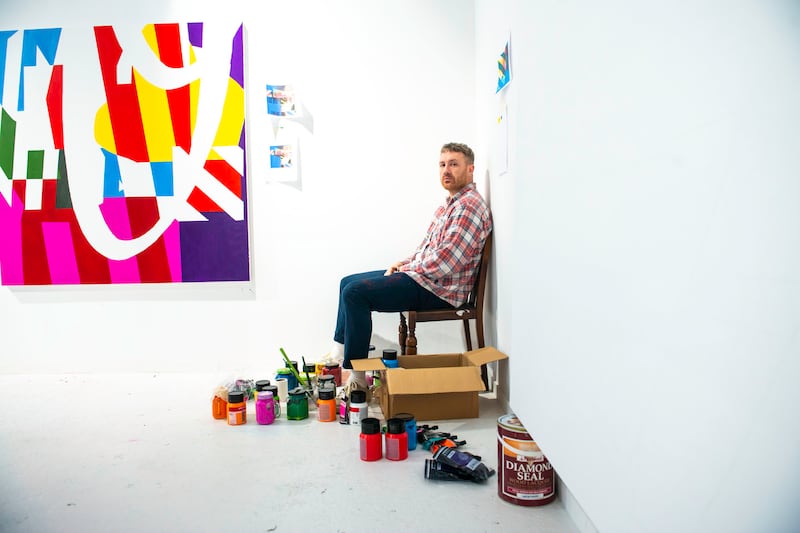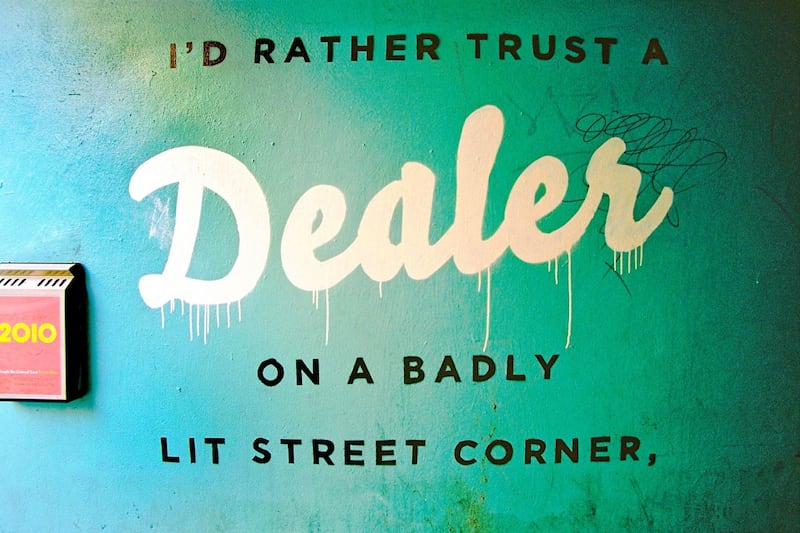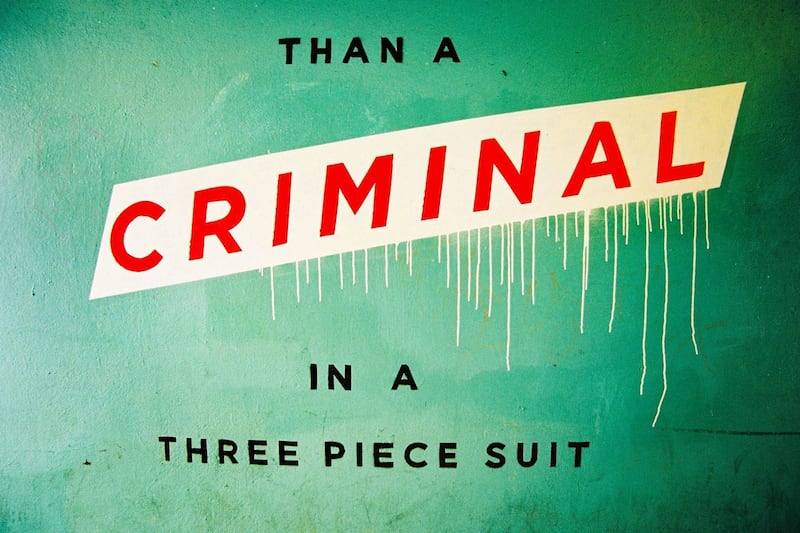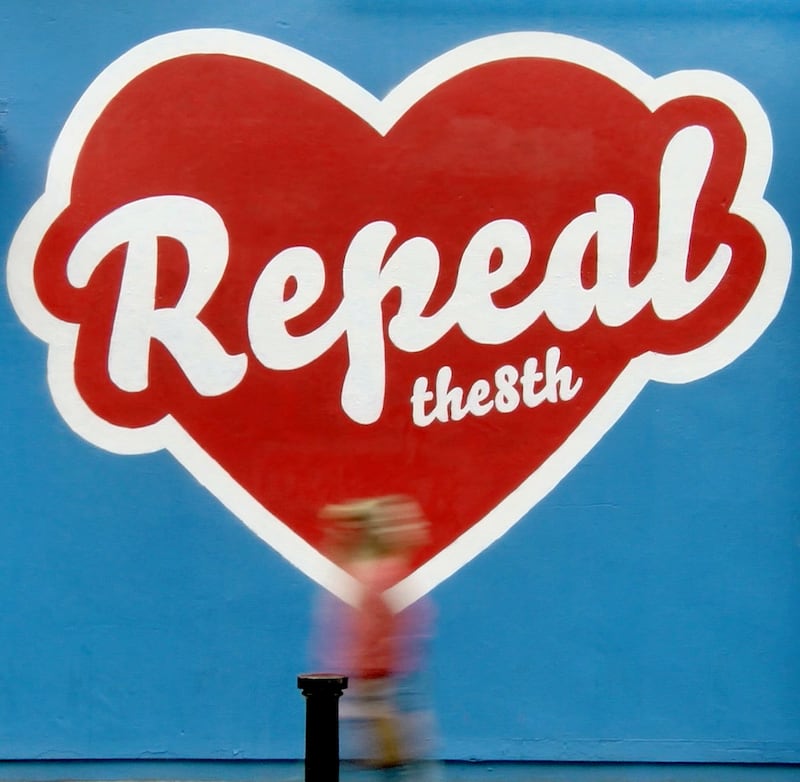When Maser began to paint, he was not Maser. First he was Al Hester, his given name. Then he was Smash. Then Maser came along. There are plenty of successful Irish artists who incubated their talent in the graffiti scene, but Maser is perhaps the most public-facing one, or at least his art is.
His tag became recognisable along the Dart line in Dublin, before the messages moved beyond the moniker. A generation has navigated the capital buffered by his proclamations of positivity – on street walls, lamp-post stickers, the sides of buildings – steeped in heartfelt simplicity and anchored in Dublin.
Maser’s work gave people a pre-Instagram spring in their step, not there for decoration but declarations to enter the psyche on a drizzly day. Some of these messages were literal, in bold signwriting. Others took the form of celebratory portraiture – Anne Devlin, BP Fallon. “Emancipate Yourself”, his sign declared on the Bernard Shaw site on South Richmond Street. His attraction to stripes lasted a while, often covering massive outdoor installations from petrol stations to motels to interactive and immersive pieces such as his installation at Smithfield for the Bram Stoker Festival in 2015.
I felt pulled from all different angles. I realised London was just adding a lot more stress. So I thought: what if I just eliminate that? Make Dublin my base and come back?
Now Maser has entered another phase, with bold deconstructed shapes writ large on canvases in progress in his new Dublin base. Atelier Maser is on Charlemont Street, in Dublin 2, and it’s a space that is rooting Maser even further in the fabric of a city that both inspires him, and from which he weaves.
The space is in a ground-floor unit of flats, part of the Charlemont Street regeneration project. These spaces tend to be largely uninspiring, often plastered with a decal of fake people fake shopping to fool no one into thinking bustle has been brought to an area. So there is something heartening about an artist’s studio and gallery now taking up a space often earmarked for a Centra- or Costa-in-waiting. Outside Atelier Maser, the artist rushes to hold open a door for an elderly woman making her way into the complex. “How are ya? Are you keeping well?”
Maser’s life now orientates itself around a few small blocks in this neighbourhood. Nearby in Portobello, he shares a house with his friend Andrea Horan, the Tropical Popical owner and activist. Before you hit that street there’s the Bernard Shaw, where Maser had his first studio upstairs. Close to that is Hang Tough, the bespoke framing spot which recently moved to Lennox Street. (“Rubio is a don,” Maser says of the owner.) Then there’s the Lower Deck pub, where Maser may go for a pint, and nearby is the gym in which he trains.

More permanent base
The space, which is essentially divided in two – wet (painting, gallery) and dry (production, admin) – is painted a petrol blue, after a powder-pink decision was reversed, not working with the industrial elements of the space, such as a silver-foil ceiling.
He had other studios before this; at the corner of Newmarket Square, in an industrial estate in Harold’s Cross, another in Dundrum, then there was his studio in Fayetteville, Arkansas, and a recent London studio. But Atelier Maser feels like a more permanent base, and his plans for it extend beyond a room to work in.
As a kid, sitting behind the family couch, tracing an image from the children's book Ann and Barry, he liked watching Bananaman and Danger Mouse, but really connected with He-Man, fostering dreams of becoming a body-builder or a lumberjack. The lumberjack thing never happened, although he's partial to a plaid shirt under a denim jacket, and his favourite activity outside of painting is hillwalking. Arnold Schwarzenegger's autobiography Total Recall sits on a studio shelf, alongside books about Haring, Matisse and Hockney, and copies of Graphotism magazine.
To see the Repeal the 8th piece get communicated and translated into other mediums, that's an artist's dream
That particular magazine opened up Maser’s world. Before he came upon it, he was down a lane in Rathmines painting an Ice Cube piece on a garage door with a can of Hammerite paint taken from his dad. His friend Gus had an older brother who was into hip hop and had a can of spray paint they used to steal, tagging walls around Dodder Park.
One day, he walked into Forbidden Planet, then on Dawson Street, and bought Graphotism. When he brought it up to the counter, the magazine wasn't on the system, but they sold it to him anyway. He turned the pages and saw images of illegal graffiti in London and Birmingham, and his lens started to focus on Dublin, where he was seeing more tags and throw-ups around the city. At 15, he began to save his money, going into town to buy spray paint in a shop upstairs in a building on Crown Alley in Temple Bar, next to a skate shop. He was labelled a "toy" – a street art term for newbie – but persisted. "I was hungry to paint, painted loads and got a name for myself. I started hanging out with these guys who were very likeminded." He found out Windmill Lane was a legal spot and headed down there. Then he just kept going.


Over the last few years, Maser says, he was critiquing himself a lot, but was on a roll nonetheless. He was travelling often, painting, being quite transient, and enjoying that. But then feelings of burnout emerged. He couldn’t settle in London, where his time there between frequent travel and return trips to Dublin, felt like the moments in-between. He’d go on the beer, wonder about the high rent for his small studio space.
Last year he took some time to himself, travelling around Singapore, Indonesia, and to Thailand to Phuket Cleanse, a detox, fitness, health and yoga retreat recommended by Horan. “I felt like I really needed to go and regroup. I felt pulled from all different angles. During that time I realised that London was just an extra thing that was unnecessary and adding a lot more stress. So I thought: what if I just eliminate that? Make Dublin my base and come back?”
The usual borderline-emigrant guilt set in. He wanted to come home, but wondered whether a return meant a regression. But being away does not necessarily mean growth and progress. “When I was in London, I got loads of opportunities, and if I stayed there and nurtured those relationships, yeah, I’d be killing it, but I know I would be compromised in terms of pace. It just didn’t sit with me. Last year, I had a bit of a rocky year. Mentally, I just felt drained. I needed to be a little bit selfish, and see what was good for me.”
Alter-ego
Maser is both an alter-ego and an articulation of self, “I nurtured that relationship with Maser. He became this person that I, Al, looked up to, and wanted to become a better person. Obviously, it’s inside me, if that makes sense. So where did all this bloody positivity come from? . . . I was literally doing it for myself. They’d be notes I’d be writing to myself. And my way of communicating is painting murals, so it just happens to be in the public realm, and loads of people see it. The messages are quite open, so people were taking ownership of them.”
While the messages in Maser’s work often reach out, a lot of the sentiment is born from self-actualisation, “There’s no cavalry coming over the hill to save you,” he says, “You’re here alone, to a degree, and you take responsibility for yourself.”
His name is on the door, but Atelier Maser again reaches out. There will be exhibitions, and assistance for younger artists. Maser likes to keep good people around – the spatial designer Niamh McCabe, his builder friend Lee, the trainer John Belton (whom Maser also views as a life coach) and others. He keeps his accountant on retainer with a view to offer financial advice to younger artists. He wants to put other artists “in a really positive, productive environment, where they can see by example”, he says, before gesturing to the space. “This in itself is an example of if you do good work and work hard, you can make shit happen. I’m still mashing it out in my brain, but it’s sort of like an incubator system where I can facilitate younger artists.”
On December 6th, the artist Peter Doyle will open a show at Atelier Maser, “He’s just f**king deadly. Raw talent. I literally look at the work and love it. I go with the gut . . . Peter Doyle’s [work] looks like he had one sock on, came in and did a bit of a paint and went and had a slice of toast and walked his dog, know what I mean? Living that integrated lifestyle where his art is an extension of him. That’s the shit that I f**king love.” His enthusiasm for other artists is infectious. He lavishes praise on Aches, a technically astonishing artist who is dominating the Dublin street landscape at the moment – “He’s the f**king man!”

But of his own work, when asked what piece he’s proudest of, the answer is instant: the Repeal the 8th mural at the Project Arts Centre. “The collective energy of that was f**king unbelievable, people taking ownership of it . . . To see that piece get communicated and translated into other mediums, that’s an artist’s dream.”
On his present work, it is “still in the midst of a journey I can’t explain yet. Most things you have to look back in hindsight and realise ‘that’s why I did that’. The graphics are very deconstructed, hard line work mixed with botanics. I got really into botanics when I was in London. I was thinking ‘f**k, is this the result of me living in this congested city?’ I’m just going with it. It’s giving me joy painting it.
“I’m looking at other artists I admire and thinking I’m just a pebble in the stream. I’m very mindful of ego getting in the way and slowing things down. I’m 37, I’ve been painting for 22 years. Over those 22 years, and more so in the past 10 years, I’ve seen people come and go. Burst of energy, ego, burn out. This is a slow-burner game. Be modest in your approach. Be respectful towards others. Be respectful to yourself as much as you can with the voices in your head. Especially as a creative, you beat yourself up so much. It’s all learning. I intend on doing this for another 50 years.”
On the studio’s large work table, a group of people, including members of Michael D Higgins’ presidential campaign, are busy packaging a limited-edition fundraising print a few days before the vote. The print is inspired by a line from a poem by the president: “Old utopias never die nor do they fade away. Born of possibility out of ancestor traces, memory gives birth to imagination.”










